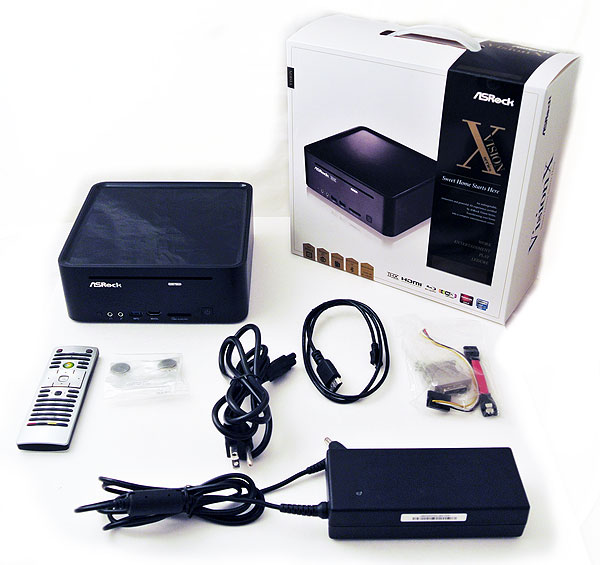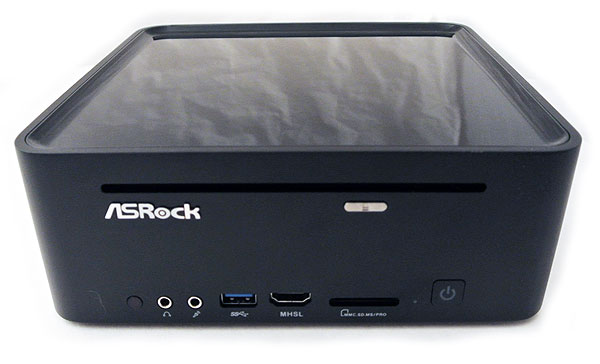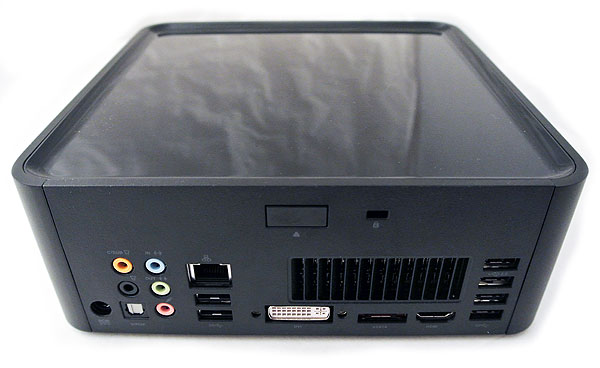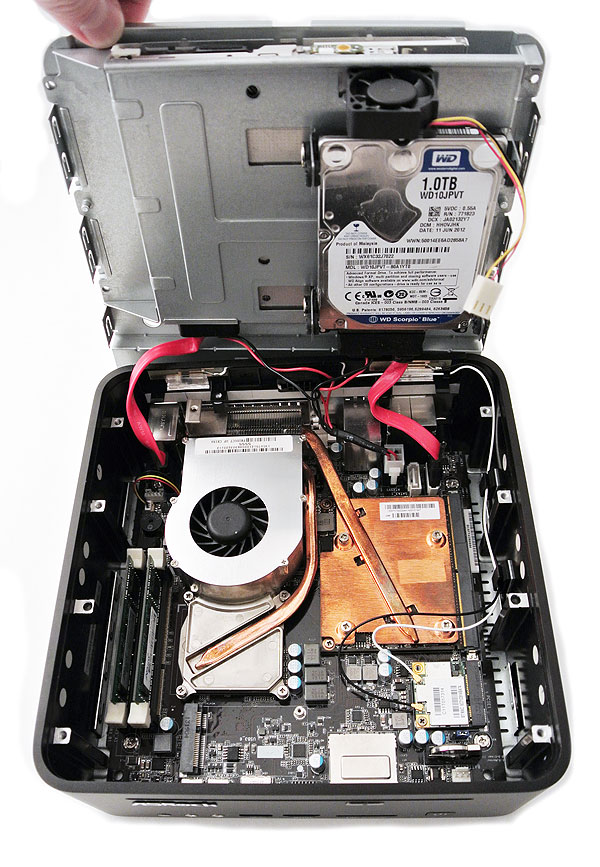Seven Small (But Powerful) Mini-PCs, Reviewed
ASRock VisionX 420D-8G1T88
Why you can trust Tom's Hardware
We've seen a number of powerful home theater-oriented mini-PCs from ASRock. The first model I reviewed was the Core 100HT-BD back in 2010. It stuck out as a high-performance option in a sea of Atom-powered nettops thanks to its Core i3 CPU. Over time, that product evolved into ASRock's Vision family, which culminates in the VisionX 420D we're evaluating today.
While the 420D's Core i5-4200M processor doesn't have the extra megabyte of shared L3 cache compared to the Core i7s in this round-up, it does offer the highest base clock rate at 2.5 GHz, and it ties the most aggressive Turbo Boost frequency of 3.1 GHz. Consequently, and helped by Intel's Haswell architecture, we expect it to lead the CPU-oriented benchmarks we'll be running.
The VisionX's real differentiator, though, is its Radeon HD 8850M graphics chipset. With 640 shader cores at 775 MHz and 1 GB of dedicated GDDR5 memory at 1125 MHz, this is essentially an underclocked Radeon HD 7770. We should see 3D performance notably quicker than the GPUs built-in to Intel's mobile processors.
Originally, ASRock told us to expect the VisionX 420D to sell for $700. With no operating system. It recently surfaced on Newegg going for $850, though. Add in $140 or so for Windows 8.1 Professional, and you're looking at close to $1000.
Bundle And First Impression

ASRock's package includes the VisionX 420D, an media center remote with batteries (this is the only bundled remote in our round-up), power and data cables for an extra SATA drive, an AC adapter and cables, and an HDMI-to-Micro-USB cable for use with the MHSL input. More on that shortly.

The Vision line's newest addition doesn't arrive in a new enclosure. ASRock continues leaning on a classy black brushed aluminum box measuring 7.9" x 7.9" x 2.8". Weighing 5.9 lbs, it's the largest and heaviest PC in our round-up, but that's somewhat relative. In reality, this system isn't much wider than a DVD.
Up front, you'll find an optical drive slot, headphone and microphone inputs, a memory card reader, an infrared sensor for the remote, a USB 3.0 port, the power button, and the MHSL input.

The rear I/O panel offers HDMI and DVI video outputs, an eSATA port, six USB ports (five of which support third-gen data rates), a GbE port, the power supply input, optical audio output, and analog audio connectors.

A single button releases the plastic cover. Immediately below is the removable optical and hard drive cage. ASRock populates the two memory slots with 4 GB of Asint DDR3-1600 for a total 8 GB, which is plenty, even for a full-sized desktop. The 1 TB Western Digital Blue mechanical drive spins at 5400 RPM. ASRock offers enthusiasts an mSATA slot if you'd prefer to boot from an SSD. Our sample came with a slim Lite-On DVD drive, though there should be an optional Blu-ray, too. ASRock is ahead of the curve when it comes to Wi-Fi, bundling a Broadcom BCM4352 802.11ac Wi-Fi card. The board also integrates Bluetooth 4.0 functionality.
Special Features And Livability
Although this is the largest PC we're testing, and even though you can't attach it to a monitor's VESA mount, the VisionX 420D justifies its size with exclusive features like optical storage and powerful discrete graphics. It's clearly aimed at the HTPC space, but is just as comfortable handling general-purpose duties on the desktop. This system is also capable in games. Thanks to its Radeon HD 8850M GPU, it's the only PC truly capable of playable 108op performance.
That MHSL (Mobile High Speed Link) port on the front of the box is the exact same size as an HDMI output. The difference is that MHSL supports both data and video, and can actually interface with MHL-compatible devices to not only charge and sync, but also to mirror their displays on a monitor. That sounds cool; however MHL compatibility is limited, including the Sony Xperia Z, Xperia Z Ultra, HTC One, and Galaxy S3 (with Micro-USB-to-five-pin-adapter).
Perhaps more practically, the MHSL input can also be used as a pass-through. For instance, you could plug a PlayStation 4 into the PC and switch between the PC and console output on the monitor using ASRock's included A-Tuning software.
| Header Cell - Column 0 | ASRock VisionX 420D |
|---|---|
| Chipset | Intel HM87 Express |
| CPU | Intel Core i5-4200M, Dual-Core, Hyper-Threaded, 2.5 GHz (3.1 GHz Peak Turbo Boost), 3 MB Shared L3 Cache |
| Graphics | Radeon HD 8850M, 775 MHz GPU |
| GraphicsMemory | 1 GB GDDR5, 1125 MHz (4500 MT/s) |
| SystemMemory | 2 x 4 GB Asint PC3-12800, 1600 MT/s DDR3, 11-11-11-28-1T |
| Hard Drive | Western Digital Blue, 1 TB, 8 MB Cache, 5400 RPM, SATA 3 Gb/s |
| Optical Drive | Lite-On DL8A4SH, Slim DVD-RW (Blu-ray optional) |
| Operating System | Not Included |
| Included Peripherals | Media Center Remote |
| Internal Interfaces | |
| Memory Support | Dual-Channel, 2 x DDR3L SO-DIMM slots, 1.35 V, 1333/1600 MT/s, 16 GB Max |
| Mini-PCIe | One slot (occupied by bundled wireless card) |
| mSATA | One slot |
| Mass Storage Controllers | |
| Chipset SATA | 3 x SATA 3 Gb/s (Two used for optical and hard drive)1 x mSATA 6 Gb/s (unused) |
| I/O Panel Connectors | |
| DVI | 1 |
| VGA | none |
| HDMI | 1 |
| DisplayPort | Not Included |
| Thunderbolt | Not Included |
| MHSL Input | 1 |
| USB | 1 x USB 2.0, 6 x USB 3.0 |
| Memory Card Reader | MMC, SD, MS/PRO |
| Network | 1 |
| eSATA | 1 |
| Digital Audio out | Optical/HDMI |
| Analog Audio | Five rear, two front |
| IR Sensor | Yes |
| Ethernet & Wireless | |
| LAN | Integrated Gigabit |
| Wi-Fi | 2T2R Dual Band, Broadcom BCM4352 802.11ac, mini-PCIe card |
| Bluetooth | Integrated Bluetooth 4.0 / 3.0 + High Speed Class II |
| Audio | |
| HD Audio Codec | Analog and S/PDIF: Realtek ALC1150HDMI: Intel Display Audio |
| Audio Channels | 7.1+2 Channel HD Audio Codec with Content Protection and DTS Connect support |
| Physical Specifications | |
| Size | 200 x 70 x 200 mm(7.87" x 2.76" x 7.87") |
| Weight | 2665 g (5.88 lbs) |
| Price | |
| As tested: $980 (with added Windows 8.1 Pro x64) |
Current page: ASRock VisionX 420D-8G1T88
Prev Page Acer Revo RL80-UR22 Next Page Gigabyte Brix GB-BXi7-4500Stay On the Cutting Edge: Get the Tom's Hardware Newsletter
Get Tom's Hardware's best news and in-depth reviews, straight to your inbox.
-
outlw6669 Not a single AMD based SFF PC?Reply
I am disappoint, this would be a great area for AMD to show their competitiveness. -
ta152h @outlw6669I built one based on the A6 5200, and it's perfect for what I need it for. It's low power, more than fast enough for what 99% of the people do, quiet, and inexpensive. I'm a little surprised they didn't choose something based on the Jaguar for that reason, but it might just be a situation where nothing with one was sent to them for review. Certainly this is a poor representation, without both Jaguar and Bay Trail missing. I got to the first page, read what they had, looked at the cases, and moved on. Reading about different versions of Ivy Bridge and Haswell and how they compare to each other is profoundly uninteresting.Reply -
m32 I wouldn't mind having a small system like this. Maybe Mid-Year when everyone's CPU/APUs are out, I'll have the chance to make a smart buy. Thanks for the article. :)Reply -
mesab66 It is interesting that by going slightly larger with the enclosure space (still keeping within cube/rectangle/media player shape) opens up the possibility of so much more power....dedicated gfx, full cpu, etc etc., and, can be cheaper to build - depending on the users requirements.......of course, at the cost of power requirements, etc. I'm thinking most folk would ideally chose a slightly larger form factor for living room/media pc duties.On the other hand, if constraints are tight (form factor in this article) and the end user's requirements match, then these options are worth considering.Reply -
s997863 Power. I don't care about no power. Where's the love for the old games? If I want to play some of the classics which just don't emulate properly, I have to hunt for a heavy old Pentium3 box and try to get it working. How about a cheap mini PC with miniaturized legacy hardware for full compatibility to dual-boot win98 & XP, with gameports, VGA & S-Video, PS/2 & USB, IDE & SATA external ribbon & power connectors, & a turbo button for choosing between 2 processors 200MHz & 3GHz?Reply -
vertexx I am a huge fan of compact systems. Almost everything I have built has been ITX. But I've had a hard time with the NUC form factor. As a desktop, I think it's actually too small. One of those boxes would get lost on my desk, continuously being pushed around by other clutter. Now, if I had a hutch with an optimally sized cubby, that might be a different story.Reply
VESA mounted on the back of a monitor, these look really clunky, and I'd rather go with an AIO kit using the thin mini-ITX form factor where I have more control over processor choice.
I'd be more excited if this technology and form factor were applied in a more interchangeable system with a standardized GPU socket. I really like what ASRock and Gigabyte have done with their compact systems. They're not as compact, but having something a little more substantial on my desk is a good thing, and they pack a lot of punch. I just wish the standards were developed to allow builders to replicate that feat - pipe dream, I know.
One thing is for sure, AMD needs to develop it's own equivalent of the NUC and thin Mini-ITX. The success of it's Kaveri line I think would be helped out by innovation in form factor. -
axehead15 I think you should compare the Mac Mini to these, that way we can see how it adds up.Reply